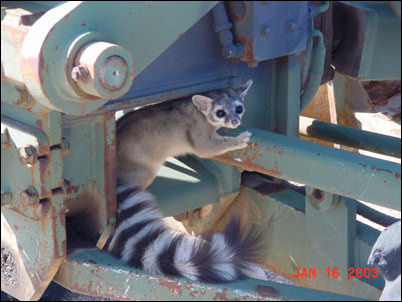

Common names often are misleading or confusing. For example, depending on where you're from, "gopher" may mean a tortoise, a ground squirrel, or a pocket gopher. But sometimes common names really are descriptive. "Ringtail" is one of these. A long, fluffy, and distinctively ringed tail is the hallmark of this graceful member of the family Procyonidae, a relative of the raccoon and the coati.
Like other members of this family, Ringtails are omnivorous, a 50-cent
word meaning that—like humans—they'll eat almost anything: fruit, insects, mice,
eggs—you name it. They are, however, somewhat more predatory than their relatives.
Inhabiting rocky canyon lands, they are constantly on the prowl during the night,
inspecting every nook and cranny that might house a tasty mouse or beetle. Wonderfully
adapted for their rugged terrain, they are agile climbers and jumpers, and even have
hind feet that can turn 180 degrees, allowing them to safely descend vertical cliff
faces. Consider yourself lucky if you spot one of these shy denizens of the
desert.

Listen to the Audio (mp3 format) as recorded by KTEP, Public Radio for the Southwest.
Contributor: Arthur H. Harris, Laboratory for Environmental Biology, Centennial Museum, University of Texas at El Paso.
Desert Diary is a joint production of the Centennial Museum and KTEP National Public Radio at the University of Texas at El Paso.

Bassariscus astutus. Photograph courtesy of the U.S. Fish & Wildlife Service.